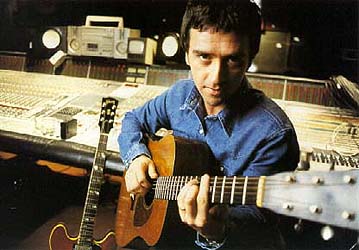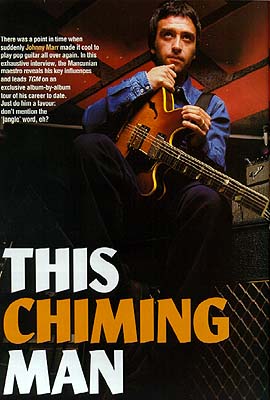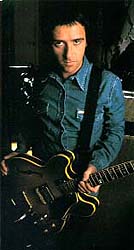February 1984
It took four studios and one completely aborted mix before The Smiths finally
issued their debut album for Rough Trade. Wild acclaim had greeted their two
singles, Hand In Glove and This Charming Man, their first
actual chart hit; the album's John Porter production was sonically somewhat
stunted, but the Morrissey/Marr songwriting partnership proved worthy of the
press hyperbole. Meanwhile the guitar talent of the 20-year-old Marr shined
through clearly, particularly on the lilting Suffer Little Children,
the flailing Hand In Glove and the muscular double-tracked riffing of What
Difference Does It Make?.
'The thing that sticks in my mind is not really liking the sound of the record,'
sighs Marr. 'It wasn't anybody's fault, particularly - just time and budget
limitations. Suffer Little Children has certainly got the atmosphere
that I intended, and Pretty Girls Make Graves was probably good as it
was ever going to be... whatever that means!'
For much of the album Marr played in regular concert tuning, but with a capo at
the 2nd fret. 'That comes from the early days of Morrissey and me writing
together,' he explains. 'I'd go round his house, play him a tune, and he'd hum
along. I soon realised it made sense for me to turn up a whole tone as he was
singing very much baritone at that time. Also, I was writing on my Gretsch Super
Axe, which just sounded better tuned up.
'That said, a lot of the album was actually recorded with a '54 Telecaster
belonging to John Porter. I used a Rickenbacker 360 12-string as well, and that
was the guitar which subsequently got all the attention, but in fact it was
mainly the Tele, and a bit of Les Paul.
'Overall, what I really didn't like about the records then was the amp, the
Roland Jazz Chorus - that's the fuckin' prime suspect. Hey man, it was the '80s!
They sounded fine to the player, but I think they failed out front. There seemed
to be [a] big hole in the sound...'
HATFUL OF HOLLOW
November 1984
A budget-priced collection of Radio 1 sessions, B-sides and new tracks that
ultimately seduced a substantially larger audience. The radio tracks displayed a
swagger and venom that had been absent from The Smiths, while Marr's
guitar was now shifted centre stage; check the quicksilver arpeggios in Girl
Afraid, the baffling chordology of William, It Was Really Nothing
and the chiming mandolin in Please, Please , Please, Let Me Get What I Want
- plus, of course, the swampy throb of How Soon Is Now?
'At the time I wasn't too sure about Hatful Of Hollow being released -
although the radio sessions were great, I was keen for them to remain just being
that. In hindsight, I realised there were certain tracks - particularly Handsome
Devil - that had something the produced version just didn't. It's a very
valid record.
'How Soon Is Now? was the one, though. I wanted to write a track with
an intro that you couldn't forget, something that you knew straight away was The
Smiths. In that regard it was very "worked on". I arrived at the
studio with a demo of the whole thing, apart from the tremolo effect - though
that was bound to surface on a Smiths track sooner or later, 'cos at that time I
was playing Bo Diddley stuff everywhere I went. I wanted it to be really, really
tense and swampy, all at the same time.
'Layering the slide part was what gave it the real tension. As soon as I played
that bit on the second and third strings, John Porter put an AMS harmoniser on
it. Then we recorded each individual string with the harmoniser, then we tuned
the B string down a half step and harmonised the whole thing.
'The tremolo effect came from laying down a regular rhythm part (with a capo
at the 2nd fret) on a Les Paul, then sending that out in to the live room
to four Fender Twins. John was controlling the tremolo on two of them and I was
controlling the other two, and whenever they went out of sync we just had to
stop the track and start all over again. It took an eternity. God bless the
sampler, 'cos it would have been so much easier! But it was just one of those
great moments.
'When Morrissey sang the vocal it was the first time we'd all heard it. John
Porter said, "Oh, great - he's singing about the elements! I am the sun
and the air..." But of course it was really, I am the son and the
heir/of a shyness that is criminally vulgar... A great track.'
MEAT IS MURDER
February 1985
The second Smiths album proper, self-produced, and yet - despite the band's
glowing reputation - it didn't yield a single hit. Marr nevertheless stretched
out with his backward guitar treatments on That Joke Isn't Funny Anymore
and Meat Is Murder, and the open tuning/overdubbing complexity of The
Headmaster Ritual. And, look out - indie-alien funk guitar ahoy on Barbarism
Begins At Home...
'The Hatful Of Hollow Radio 1 sessions were really just banged out and
ended up sounding great, so I thought, "Why use a name producer? We'll do
it ourselves." I really like That Joke Isn't Funny Anymore, the
title track and The Headmaster Ritual - as guitar pieces they took me a
long time to do, and songs like that don't come around that often.
'The nuts and bolts of The Headmaster Ritual came together during the
first album, and I just carried on playing around with it. It started off as a
very sublime sort of Joni Mitchell-esque chord figure; I played it to Morrissey
but we never took it further. Then, as my life got more and more intense, so did
the song. The bridge and the chorus part were originally for another song, but I
put them together with the first part. That was unusual for me; normally I just
hammer away at an idea until I've got a song. It's in open D turning, with a
capo at the second fret. Again, it was heavily overdubbed. It was a very
exciting period for me - realising I could hijack 16 tracks all for myself.'
Some reckon it to be Marr's strongest guitar LP with The Smiths...
'Really? In hindsight, I wasn't happy with the overall sound. I think it's too
thin. And artistically, I think Meat Is Murder is the least successful
of all The Smiths' albums. Some of the songs are just played too fast. That's me
- I'm terrible for just speeding things up. Super hyper!'
While Marr's orchestral guitar arrangements on record were undoubtedly
impressive, it was at this point he realised that the band's live sound badly
needed bolstering up. 'When you go out live you want to give people at least a
general impression of the whole thing, but if you're on your own, you end up
compromising a lot of the chord inversions and inflections that were there in
the overdubs,' he explains. 'You generally end up being reduced to playing that
big-sounding first position chord. With my one-man band approach I managed that
fairly successfully for a while, but other times it didn't really work. From a
guitar point of view That Joke Isn't Funny Anymore could have been
absolutely incredible live, but in the end it was only good.'
Once the Meat Is Murder tour was over Marr decided to add a second
guitarist, Craig Gannon, for live dates.
THE QUEEN IS DEAD
June 1986
'Album of the '80s,' cooed the critics, and ardent fans tend to agree: this is
The Smiths' masterpiece. Although behind the scenes things were becoming
extremely fraught, Marr still judged Bigmouth Strikes Again to be 'my
very own Jumpin' Jack Flash'. The Boy With The Thorn In His Side
exhibited an able pop touch, and the Stooges-influenced title track's aggressive
wah rock frenzy was further enlivened by an eerie 'woohing' noise in the
background...
 'I'd done
the rhythm track for The Queen Is Dead, and left the guitar on the
stand. The wah pedal just happened to be half open, and putting the guitar down
made the guitar suddenly hit off this harmonic. We were back at the desk playing
back the rhythm track and I could still hear this harmonic wailing away, so we
put the tape back onto record while I crept back into the booth and started
opening up the wah-wah, thinking "Don't die, don't die!" Eventually I
opened up the pedal, and "Wooooohhhhhh!" Kept it going, too. Great
accident.'
'I'd done
the rhythm track for The Queen Is Dead, and left the guitar on the
stand. The wah pedal just happened to be half open, and putting the guitar down
made the guitar suddenly hit off this harmonic. We were back at the desk playing
back the rhythm track and I could still hear this harmonic wailing away, so we
put the tape back onto record while I crept back into the booth and started
opening up the wah-wah, thinking "Don't die, don't die!" Eventually I
opened up the pedal, and "Wooooohhhhhh!" Kept it going, too. Great
accident.'
More open tuning frippery came in the form of Morrissey's mis-spelt Cemetry
Gates. 'When we signed with Rough Trade we were being hailed as The Great
New Songwriters, and I was on the train coming back thinking, "Right, if
you're so great - first thing in the morning, sit down and write A Great
Song." I started with Cemetry Gates' BM to G change in open G...
'Sonically we got it right, but it was a very dark album that came out of a very
dark period. I remember, when I was a kid, bands used to describe album
environments as being very womb-like, which always fascinated me as an idea...
now I know! Once was enough, making an album like that - I was really putting
myself out on the edge. I know that sounds very humourless, and we did have a
good time making it, but it was a bit like that. We had no manager, so me and
Morrissey were trying to run the whole band, plus we were still on an
independent label, but out of all that adversity we still managed to make this
great album. A song like Never Had No One Ever could only have come out
of that mindset - fucked-up.'
STRANGEWAYS, HERE WE COME
September 1987
By the time Strangeways... reached the record racks, The Smiths were no
more. Cocky coves claim they can hear clues in the grooves: Morrissey's lyrical
preoccupation with death, the absence of guitar (yikes!) on the opening track,
Marr's splintered riffing and production, his gaunt and frankly ill appearance
in press photos. Further 'proof' was cited in Morrissey's lyrics for I Won't
Share You, an 'obvious' kiss-off to his session-hungry partner. Doh!
Unbridled woe and much burning of cardigans ensued...
'Actually, it's my favourite Smiths album. We split after we recorded it and
they were good sessions. One or two of the songs are acoustic-led (Girlfriend
In A Coma and Unhappy Birthday) which I really liked - now that
was an organic record.
'I wanted the electric guitar parts a lot less layered and with a lot more
weight, which you can hear on I Started Something I Couldn't Finish.
The stuff that wasn't acoustic was mainly led by my 355 12-string; in fact, a
lot of the songs - I Started Something..., Paint A Vulgar Picture
and Stop Me If You've Heard This One Before - were written on that
guitar. It gave a really big sound. I wanted to make sure my main guitar parts
really counted and stayed on the record. Often, before, I had changed the main
foundation at a later date, but that didn't happen with Strangeways.'
Coincidence or not, Marr also chose Paint A Vulgar Picture to 'lay
down' his first guitar solo proper...
'Yeah, it was a big deal!' he grins wryly. 'I had to make everyone leave the
studio, bring in a few candles... no, not really. The song just suited it. I
always thought that if you played a guitar solo it should be something people
could whistle... mind you, since then I've recorded solos that even Roger
Whittaker would have problems whistling.
'One of the main things that was frustrating me about The Smiths was the way I
was getting boxed. Anyone with half an ear could listen to The Smiths records
and hear hard guitars, distorted guitars, backwards guitars, slide guitars,
acoustics, Nashville tunings, open tunings... yet every time I opened a music
paper it said, "Johnny Marr - jingle jangle." I'd just had enough...'
After The Smiths split, Marr cropped up on various sessions - backing Bryan
Ferry on his Bete Noir LP (The Right Stuff single was a vocal
version of Marr's Smiths instrumental Money Changes Everything), on the
Colors film soundtrack, some tasty work on Kirsty McColl's Kite
album, a few songs on Talking Head's Naked. For a while it looked like
he would join The Pretenders (he played on their Windows Of The World
single and even completed a short tour) but his first full-time project was as
new guitarist in The The. 'I'd actually met Matt Johnson before The Smiths,'
recalls Marr, 'it was just finances and geography that kept us apart. We hit it
off straight away when we first met - he played me something off Burning
Blue Soul, and I played him the music that eventually became Suffer
Little Children, and we really connected. He was the only other person I
knew playing in a similar sort of style as me. When I was in The Smiths I'd
always listen to Matt's records and think "I could do that better" -
heheh!
'The way we got together was amazing synchronicity. You see, I really wanted to
play with David Palmer (drums, one-time ABC-er) and James Eller (bass,
just exited Julian Cope's band) and I talked about putting a band together
with them, but at the same time Matt talked to each of us individually about
playing with The The - and hey presto, we all joined The The. It was perfect for
me in many ways, 'cos it allowed me to continue to be a musician and do
something intense, but to stay completely away from the media hullabaloo that
was going on around The Smiths' split.'

 The lush
production work of '60's maverick Phil Spector provided the next impetus. 'When
I heard his records, a whole new world opened up to me,' Marr discloses. 'Even
back then, I didn't so much listen to music as study it. I'd put on records,
whether by a favourite group like T-Rex or just some naff pop record, and if the
middle eight didn't appear where I thought it should or if the fade-out was too
short, I'd get really frustrated! Having my head buried in the speakers,
listening out for those things sort of grew in tandem with my obsession for
guitars. And that's been with me for as long as I can remember.
The lush
production work of '60's maverick Phil Spector provided the next impetus. 'When
I heard his records, a whole new world opened up to me,' Marr discloses. 'Even
back then, I didn't so much listen to music as study it. I'd put on records,
whether by a favourite group like T-Rex or just some naff pop record, and if the
middle eight didn't appear where I thought it should or if the fade-out was too
short, I'd get really frustrated! Having my head buried in the speakers,
listening out for those things sort of grew in tandem with my obsession for
guitars. And that's been with me for as long as I can remember. 'I'd done
the rhythm track for The Queen Is Dead, and left the guitar on the
stand. The wah pedal just happened to be half open, and putting the guitar down
made the guitar suddenly hit off this harmonic. We were back at the desk playing
back the rhythm track and I could still hear this harmonic wailing away, so we
put the tape back onto record while I crept back into the booth and started
opening up the wah-wah, thinking "Don't die, don't die!" Eventually I
opened up the pedal, and "Wooooohhhhhh!" Kept it going, too. Great
accident.'
'I'd done
the rhythm track for The Queen Is Dead, and left the guitar on the
stand. The wah pedal just happened to be half open, and putting the guitar down
made the guitar suddenly hit off this harmonic. We were back at the desk playing
back the rhythm track and I could still hear this harmonic wailing away, so we
put the tape back onto record while I crept back into the booth and started
opening up the wah-wah, thinking "Don't die, don't die!" Eventually I
opened up the pedal, and "Wooooohhhhhh!" Kept it going, too. Great
accident.'